Qualcomm Snapdragon 805 Performance Preview
by Anand Lal Shimpi on May 21, 2014 8:00 PM EST- Posted in
- Tablets
- Snapdragon
- Qualcomm
- Mobile
- SoCs
- Snapdragon 805
CPU Performance
As always we'll start out our performance investigation with a handful of CPU bound web browser based tests. In all cases we used Chrome on the MDP/T. Remember there's only an 8% increase in peak CPU frequency here, so I wouldn't expect a huge difference vs. Snapdragon 801.
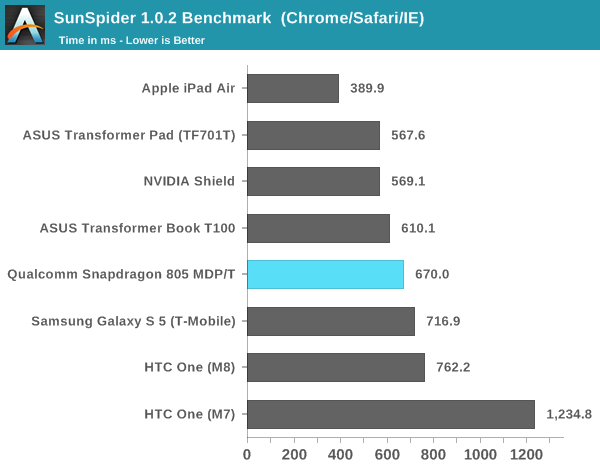
Here the MDP/T scales pretty well, showing a 6% improvement in performance over the Snapdragon 801 based Galaxy S 5. In the case of the GS5 we are looking at a 2.5GHz Snapdragon 801 implementation, so the improvement makes sense. Both the Cortex A15 (TF701T/Shield) and Apple's Cyclone (in the iPad Air) are higher performing designs here. Since there's no fundamental change to Krait's IPC, the only gains we see here are from the higher clock speed.
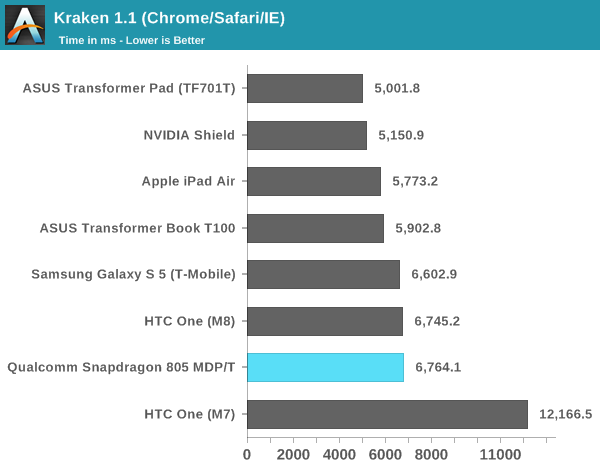
Kraken appears to be at its limit when it comes to Krait 400/450, there's effectively no additional frequency scaling beyond 2.3GHz. We're either running into an architectural limitation or limits of the software/browser combination itself.
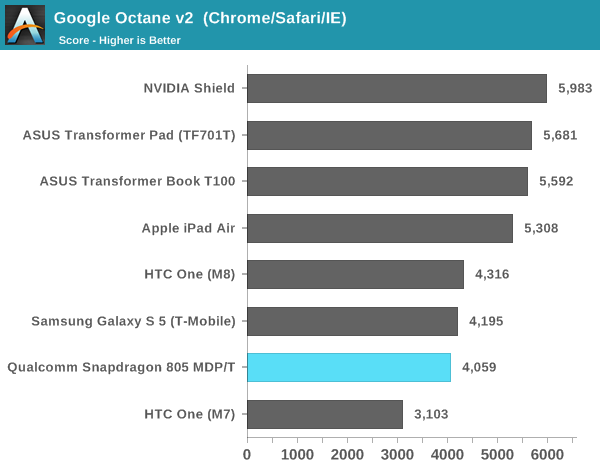
Similarly we don't see any real progress in the Google Octane test either. Snapdragon 805's CPU cores may run at a higher peak frequency but that's definitely not the story here.
Basemark OS II
Basemark OS II gives us a look at native application performance across a variety of metrics. There are tests that hit the CPU, GPU as well as storage subsystems here. The gains here are exclusively on the graphics side, which makes sense given what we've just seen. Snapdragon 805's biggest gains will be GPU facing.
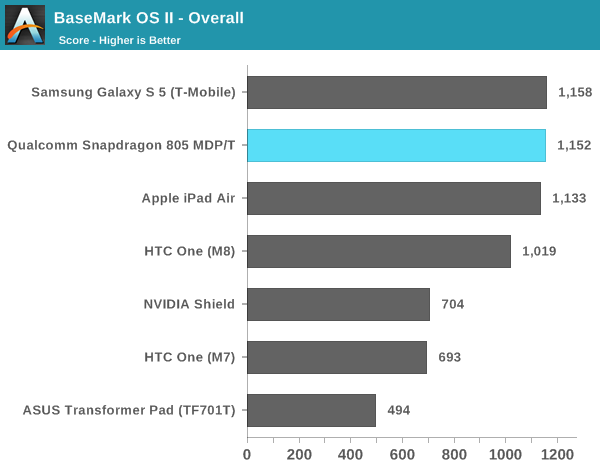
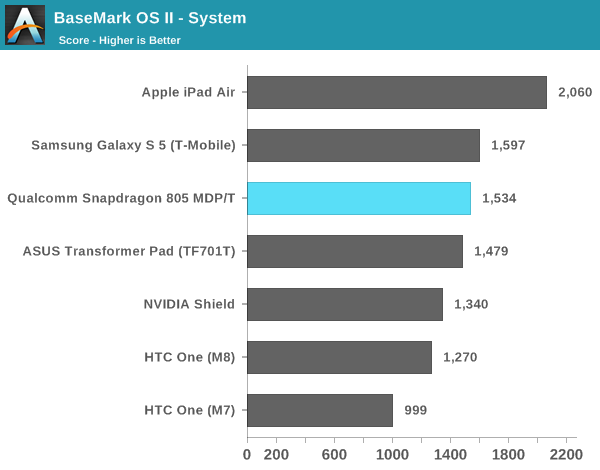


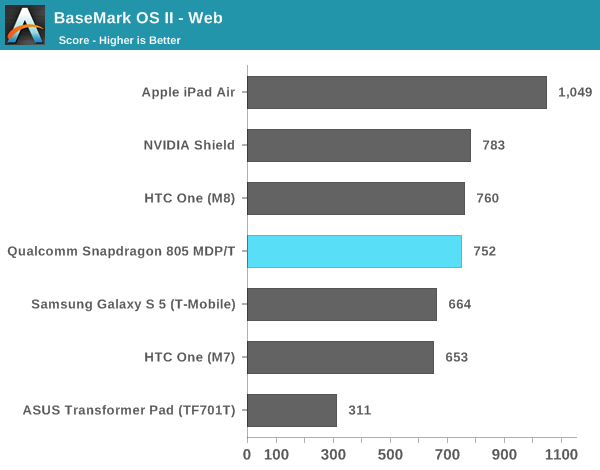
Geekbench 3.0
Although I don't typically use Geekbench, I wanted to include some numbers here to highlight that the increase in memory bandwidth for S805 over S801 doesn't really benefit the CPU cores:
| Geekbench 3.0 | |||||
| Snapdragon 801 2.3GHz (HTC M8) | Snapdragon 805 2.7GHz (MDP/T) | % Increase for S805 | |||
| Overall (Single thread) | 1001 | 1049 | 4.8% | ||
| Overall (Multi-threaded) | 2622 | 2878 | 9.7% | ||
| Integer (Single thread) | 956 | 996 | 4.2% | ||
| Integer (Multi-threaded) | 2999 | 3037 | 1.3% | ||
| FP (Single thread) | 843 | 925 | 9.7% | ||
| FP (Multi-threaded) | 2636 | 3155 | 19.7% | ||
| Memory (Single thread) | 1411 | 1406 | 0% | ||
| Memory (Multi-threaded) | 1841 | 1949 | 6% | ||
I wouldn't read too much into the multithreaded FP results, I suspect we're mostly seeing differences in thermal dissipation of the two test units. A closer look at the memory bandwidth numbers confirms that while the 805 has more memory bandwidth, most of it is reserved for GPU use:
| Geekbench 3.0 - Memory Bandwidth | |||||
| Snapdragon 801 2.3GHz (HTC M8) | Snapdragon 805 2.7GHz (MDP/T) | % Increase for S805 | |||
| Stream Copy (Single thread) | 7.89 GB/s | 8.04 GB/s | 1.9% | ||
| Stream Copy (Multi-threaded) | 9.53 GB/s | 10.1 GB/s | 5.9% | ||
| Stream Scale (Single thread) | 5.36 GB/s | 5.06 GB/s | - | ||
| Stream Scale (Multi-threaded) | 7.31 GB/s | 7.63 GB/s | 4.3% | ||
| Stream Add (Single thread) | 5.27 GB/s | 5.2 GB/s | - | ||
| Stream Add (Multi-threaded) | 6.84 GB/s | 7.51 GB/s | 9.8% | ||
| Stream Triad (Single thread) | 5.64 GB/s | 5.85 GB/s | 3.7% | ||
| Stream Triad (Multi-threaded) | 7.65 GB/s | 7.89 GB/s | 3.1% | ||










149 Comments
View All Comments
kron123456789 - Thursday, May 22, 2014 - link
Well, i don't belive it because of benchmarking results. Nvidia promised 60fps in T-Rex HD, and here it is. And Nvidia also promised 2.5x performance on Manhattan Offscreen test compared Apple's A7. And here it is(30fps vs 13.3fps). Well, almost 2.5x.AnandTechUser99 - Thursday, May 22, 2014 - link
NVIDIA had shown us the benchmarks in January.When the iPad Mini Retina (and other A7 devices) had been benchmarked towards the end of January in Manhattan Offscreen 1080p, they had average scores closer to 667 (10.8 Fps). Based off of this score, the Tegra K1 was offering a score ~2.65x that of the A7.
Sometime around March 10th, the average score for Apple's A7 had changed to 803 (13.0 Fps). I assume there was some sort of software update that boosted their Manhattan score.
Ghost420 - Friday, May 23, 2014 - link
i'm glad that if it is down clocked to 600mhz in the MiPad, benchmarks shows it's still kicking QC buttGhost420 - Friday, May 23, 2014 - link
on a side note, this is very good for SOC competition...hopefullyArthurG - Thursday, May 22, 2014 - link
So read this:http://en.miui.com/thread-22041-1-1.html
5hours heavy 3D game on 6700mAH battery means that TK1 runs with ~3W
and 11 hours on video
so excellent numbers when taking into account the leading performance
testbug00 - Thursday, May 22, 2014 - link
about 5 hours. Hm, I wish they had ran the tests longer... Ideally (for testing purposes, not time purposes) they would have ran everything for 20-25%(+) of the tablets battery life, and used that.OR
Did the tests from 75% or 50% battery.
Using 15 minutes (read: 5%) is a bit low amount of battery wear... It should be pretty accurate, but, I would skew that test a little lower (my experience is phones (over 5 phones) and tablets (over 2 tablets) tend to lose the first few percent of battery the slowest, and, it gives an inflated battery life.
According to the first 5% of battery (from 100% to 95%) on an iPad mini, well, It gave me something like 8 hours of usage playing hearthstone...
Same with video watching on Nook HD+
Same with Video (and reading webpages) watching on 920/1020
Same on reading webpages/playing weak applications on my Moto G
Same with web pages on some cheapass Android LG
Same with video/web pages on my old iPhone 4.
I would guess the real battery is closer to 4-4.5 hours (happy to be proven wrong ^__^) and the SoC is not running max clock (for good reason, no need to run max clock when you already hit a game fps gap, or, the refresh rate of the tablet)
Ghost0420 - Wednesday, May 28, 2014 - link
Doesn't Asus have a TF701T? which uses a Tegra 4 @ 1.9Mhz, WITHOUT A FAN? One bad review, because Toshiba don't know how to make a tablet, and everyone thinks T4 runs hot. The fan in the Shield is very quite and doesn't 'spool' up as if T4 was overheating, it runs very smoothly and the the interface is very smooth. Also, streaming AWAY from your house on good WiFi for PC games is working quite well now.And at least NV is updating its software....consistently...unlike most OEMs.
TheJian - Wednesday, May 21, 2014 - link
Agreed. Also Denver is in house where 810 isn't. I would expect CPU stuff to show Denver is better on power when taxed as Qcom in house won't be around until late 2015 or Q1 2016 since 810 is 1h2015. The GPU will heavily favor NV (even AMD at some point if they get in with a good SOC) as nobody else but AMD has 20yrs of gaming experience. We already have seen K1 is pretty good against the 805. Odd they ran from battery here..."Here even NVIDIA's Shield with Tegra 4 cooled by a fan can't outperform the Adreno 420 GPU"
Anandtech needs to stop makings dumb NV statements. It's a YEAR old device and won't even be in this race, not to mention it's not getting a ton from the fan anyway which is really there for longevity and temps in the hands for hours (we game hard and for hours so keeps it cool). The fan isn't in there to hit 2.5ghz or something, it's 1.9. This device will be facing K1. Stop taking AMD checks to be their portal site, and you can get back to making unbiased reporting without the little BS NV digs.
ArthurG - Thursday, May 22, 2014 - link
So true for the last paragraph !Let's see if Anand will say "TK1 Kepler GPU smokes Adreno 420, providing twice the performance on GFX3.0 bench with half memory bandwidth"
I'm waiting for it, right Anand ?
ams23 - Thursday, May 22, 2014 - link
Technically the difference in memory bandwidth is closer to 50% due to differences in mem. operating speeds for these two SoC's.